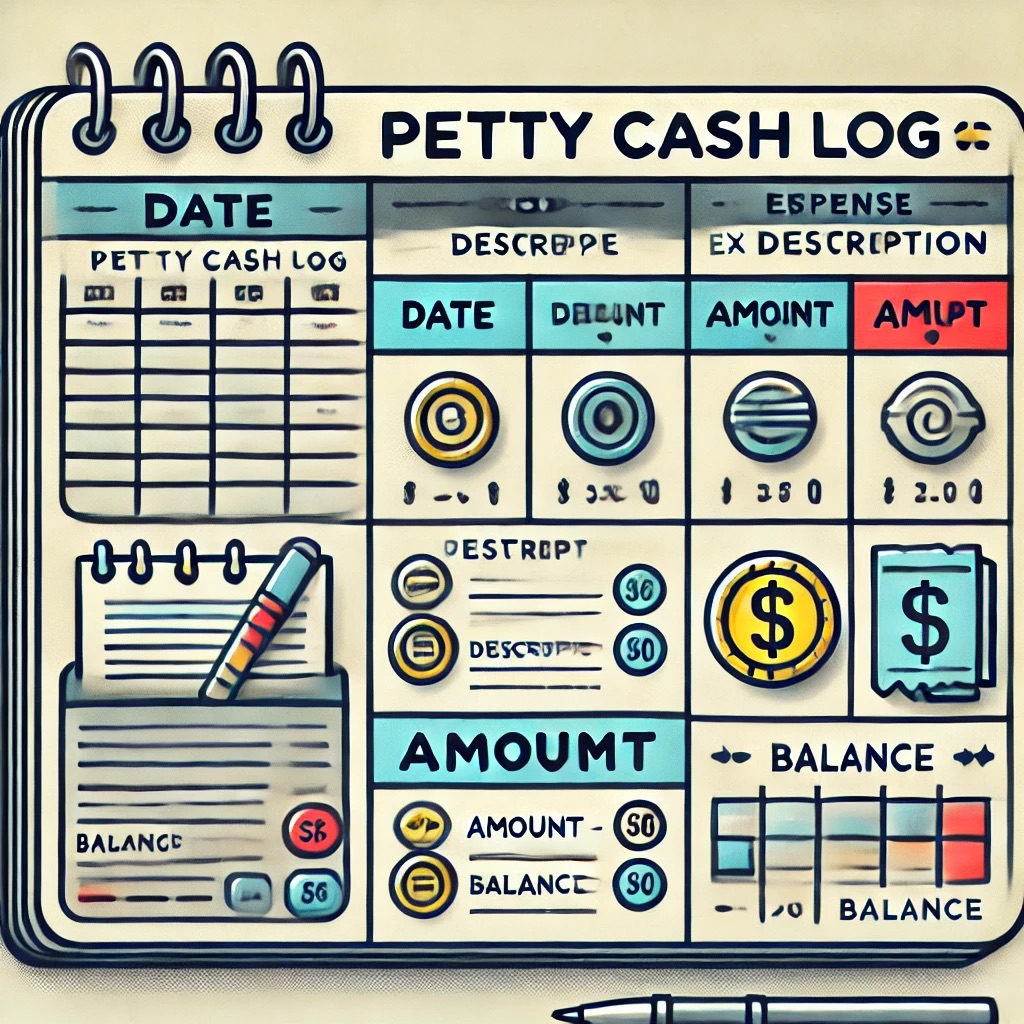Petty Cash Log: Simple Steps to Manage Small Expenses

Managing every penny spent is a critical practice for businesses looking to maintain financial stability and transparency. Small expenses such as office supplies, parking fees, or lunch reimbursements might seem minor, but they quickly add up and can impact your budget if not properly tracked.
A petty cash log is an essential tool that enables businesses to monitor, manage, and document these small but frequent expenditures effectively. In this guide, you’ll learn the purpose of a petty cash log, how to create and reconcile it, and tips for optimizing its use.

What Is Petty Cash and Why Is It Important?
Petty cash refers to a small reserve of money that businesses keep on hand for minor or unexpected expenses. This fund is managed through a petty cash log, a record-keeping tool that documents every transaction to ensure accountability and transparency.
Examples of Petty Cash Uses
- Purchasing office supplies
- Paying for parking or tolls
- Employee reimbursements for small purchases
- Covering miscellaneous operational costs like coffee or snacks
Petty cash ensures that these small transactions don’t disrupt the company’s primary cash flow or require elaborate approval processes.
Benefits of Using a Petty Cash Log
A petty cash log simplifies financial management by offering:
- Transparency: Ensures every transaction is documented with receipts and recorded accurately.
- Accountability: Designates responsibility to a custodian who oversees its use.
- Efficiency: Quickly covers minor expenses without delays caused by formal approval systems.
- Reconciliation: Helps identify discrepancies and maintain an accurate account balance.
However, like any financial tool, it requires strict management to avoid misuse or errors.
How to Create a Petty Cash Fund
Establishing a petty cash fund involves several steps to ensure proper setup and management.
1. Get a Secure Petty Cash Box
Purchase a durable box with compartments for coins, cash, and receipts. It should have a lock and key for security.
2. Establish a Petty Cash Float
Decide on an initial amount to fund the petty cash box. For instance, $200 might be sufficient for a small business. The float represents the total cash available, and it will be replenished as needed.
3. Assign a Petty Cash Custodian
Designate one individual to manage the petty cash, issue payments, and track receipts. This ensures consistency and accountability.
4. Create a Petty Cash Voucher System
Use vouchers to document each transaction. A voucher should include:
- Date of transaction
- Amount spent
- Purpose or description of the expense
- Signature of the recipient or custodian
5. Set Rules for Usage
Define what expenses qualify for petty cash usage and require receipts for every transaction.
How to Reconcile a Petty Cash Fund
Reconciliation ensures the recorded transactions match the actual cash remaining. Follow these steps for effective reconciliation:
- Count the Remaining Cash: Open the petty cash box and count the cash left.
- Review Receipts and Vouchers: Verify all transactions recorded in the log have corresponding receipts or vouchers.
- Compare Records: Match the receipts with entries in the petty cash log.
- Calculate the Ending Balance: Subtract the total expenses from the initial float to determine the expected cash remaining.
- Replenish the Fund: Add cash to restore the float to its original amount.
Petty Cash Log Template: Key Components
A well-designed petty cash log template should include:
- Date of Transaction: When the expense occurred.
- Description of Expense: Purpose or details of the purchase.
- Amount Spent: Exact amount withdrawn.
- Name of Employee: Who received or used the cash.
- Remaining Balance: Updated cash left after each transaction.
Using a consistent format ensures clarity and accuracy.
Tips for Managing a Petty Cash Fund
1. Use Tracking Systems
In addition to physical logs, consider digital tools like Excel templates or accounting software to maintain accurate records. Templates provide customizable columns for tracking deposits, withdrawals, and balances.
2. Conduct Regular Audits
Periodic audits help detect discrepancies and ensure compliance with company policies. Both the custodian and management should verify the records.
3. Limit Access
Restrict petty cash access to authorized personnel to prevent misuse.
4. Set Spending Limits
Establish maximum amounts for transactions to control expenses.
Petty Cash Management Systems
There are two common systems for managing petty cash:
1. Ordinary Petty Cash Fund
- Cashier receives a small fixed amount (float).
- Once funds are depleted, a reconciliation report is submitted for reimbursement.
2. Advanced Petty Cash Fund
- A larger float is issued to cover extended periods or higher expenses.
- Reimbursement occurs regularly as receipts are submitted.
Choose the system that best aligns with your business size and expense patterns.
Petty Cash Log Templates
Creating a petty cash log from scratch can be time-consuming. Fortunately, templates simplify the process. Here are some options:
Template 1: Printable Petty Cash Log
- Includes columns for date, description, amount, and balance.
- Suitable for manual records.
Template 2: Excel Petty Cash Log
- Automated calculations for quick reconciliation.
- Easy to customize for different business needs.
Template 3: Simple Petty Cash Form
- Minimalist design for smaller businesses.
- Tracks basic details like transactions and approvals.
Template 4: Detailed Petty Cash Tracker
- Includes fields for department, custodian, and additional notes.
- Ideal for larger organizations.
These templates are readily available online and can be customized to fit your specific requirements.
Digital Tools for Managing Petty Cash
Microsoft Excel is a popular choice for managing petty cash logs. It allows you to:
- Automate calculations.
- Track multiple transactions efficiently.
- Customize templates with formulas and filters.
If you don’t have Excel, consider purchasing a Microsoft Office package from trusted retailers like RoyalCDKeys, offering affordable activation keys.
Example of Petty Cash Usage
Imagine you own a coffee shop and run out of napkins. You allocate $50 from the petty cash fund to an employee for purchasing supplies. Here’s how you record it:
- Take the receipt and update the petty cash log.
- Deduct $50 from the float and note the new balance.
- File the receipt in the petty cash box for reconciliation.
This straightforward process ensures transparency and accountability.
Conclusion
A petty cash log is a critical tool for any business aiming to manage its small expenses effectively. By using a log, you can track every transaction, ensure accurate reconciliations, and avoid financial discrepancies. Whether you manage petty cash manually or through digital tools, consistency and accountability are key to success.
Start implementing a petty cash log in your business today to improve organization and financial management.
Source: Petty Cash Log: Easily Keep Track Of Small Expenses
Check out our latest post: Effective Project Planning with a Network Diagram Guide









